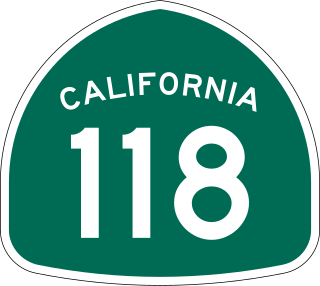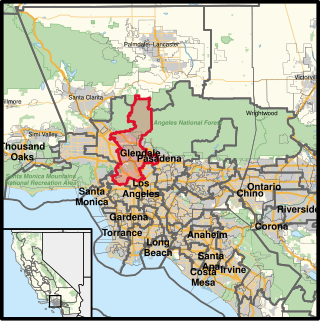
The San Fernando Valley, known locally as the Valley, is an urbanized valley in Los Angeles County, California. Situated northwards of the Los Angeles Basin, it comprises a large portion of Los Angeles, the incorporated cities of Burbank, Calabasas, Glendale, Hidden Hills and San Fernando, plus several unincorporated areas. The valley is the home of Warner Bros. Studios, Walt Disney Studios, and the Universal Studios Hollywood theme park.

Pacoima is a neighborhood in Los Angeles, California. It is one of the oldest neighborhoods in the San Fernando Valley region of LA.

Sun Valley is a neighborhood in Los Angeles, California in the San Fernando Valley region. The neighborhood is known for its younger population. There are three recreation centers in Sun Valley, one of which is a historic site. The neighborhood has thirteen public schools—including John H. Francis Polytechnic High School and Valley Oaks Center for Enriched Studies (VOCES)—and four private schools.

State Route 118 is a state highway in the U.S. state of California that runs west to east through Ventura and Los Angeles counties. It travels from State Route 126 at the eastern edge of Ventura immediately northwest of Saticoy, then through Saticoy, in Ventura County east to Interstate 210 near Lake View Terrace in Los Angeles. SR 118 crosses the Santa Susana Pass and the northern rim of the San Fernando Valley along its route.

Lake View Terrace is a suburban neighborhood in the San Fernando Valley region of the City of Los Angeles, California.

The Crescenta Valley is a small inland valley in Los Angeles County, California, lying between the San Gabriel Mountains on the northeast and the Verdugo Mountains and San Rafael Hills on the southwest. It opens into the San Fernando Valley at the northwest and the San Gabriel Valley at the southeast. It is nearly bisected by the Verdugo Wash, a smaller valley separating the Verdugo Mountains from the San Rafael Hills. Most of the valley lies at an elevation of over 1,500 feet.

The Verdugo Mountains, also known as the Verdugo Hills or simply The Verdugos, are a small, rugged mountain range of the Transverse Ranges system in Los Angeles County, California. Located just south of the western San Gabriel Mountains, the Verdugo Mountains region incorporates the cities of Burbank, Glendale, Pasadena, and La Cañada Flintridge; the unincorporated communities of Altadena and La Crescenta-Montrose; as well as the City of Los Angeles neighborhood of Sunland-Tujunga. It is where the borders of the San Gabriel Valley and the San Fernando Valley meet.

Hansen Dam is a dam built for flood control in the northeastern San Fernando Valley, in the Lake View Terrace neighborhood of Los Angeles, California. The dam was built by the U.S. Army Corps of Engineers, Los Angeles District in 1940. Hansen Dam was named after horse ranchers Homer and Marie Hansen, who established a ranch in the 19th century.

San Fernando Road is a major street in the City of Los Angeles and Los Angeles County. Within the Burbank city limits it is signed as San Fernando Boulevard, and north of Newhall Pass it is signed as The Old Road. It was previously designated as Business Loop 5 in the 1970s.

California's 29th congressional district is a congressional district in the U.S. state of California based in the north central San Fernando Valley. The district is represented by Democrat Luz Rivas.

California's 30th congressional district is a congressional district in the U.S. state of California. The district was represented by Democrat Adam Schiff until December 2024 when he was elected to the senate. Democrat Laura Friedman was elected to succeed him, and took office in January 2025.

California's 20th senatorial district is one of 40 California State Senate districts. It is currently represented by Democrat Caroline Menjivar of Los Angeles.

Pacoima Wash, 33 miles (53 km) long, is a major tributary of the Tujunga Wash, itself a tributary of the Los Angeles River, in the San Fernando Valley of Los Angeles County, California.

Burbank Western Channel is a 6.3-mile-long (10.1 km) tributary of the Los Angeles River in the eastern San Fernando Valley of Los Angeles County, California.

Los Angeles's 1st City Council district is one of the fifteen districts in the Los Angeles City Council. It is currently represented by Democrat Eunisses Hernandez since 2022, after she beat previous councilmember Gil Cedillo that year.

Los Angeles's 2nd City Council district is one of the fifteen districts in the Los Angeles City Council. It is currently represented by Democrat Adrin Nazarian since 2024, previous councilmember Paul Krekorian is term limited.

Sunland-Tujunga is a Los Angeles city neighborhood within the Crescenta Valley and Verdugo Mountains. Sunland and Tujunga began as separate settlements and today are linked through a single police station, branch library, neighborhood council, chamber of commerce, city council district, and high school. The merging of these communities under a hyphenated name goes back as far as 1928. Sunland-Tujunga contains the highest point of the city, Mount Lukens.

Los Angeles's 7th City Council district is one of the fifteen districts in the Los Angeles City Council. It is currently represented by Democrat Monica Rodriguez since 2017 after winning an election to succeed Felipe Fuentes, who resigned the year prior.

The La Tuna Fire was a wildfire in the Verdugo Mountains in Los Angeles County, Southern California, in September 2017. The fire began from undetermined causes on the afternoon of September 1 in La Tuna Canyon, and burned 7,194 acres (2,911 ha) before its containment on September 9. The fire caused at least ten injuries, the destruction of five homes and five outbuildings, and the evacuations of hundreds more. It was one of the largest wildfires in the history of the city of Los Angeles.





















